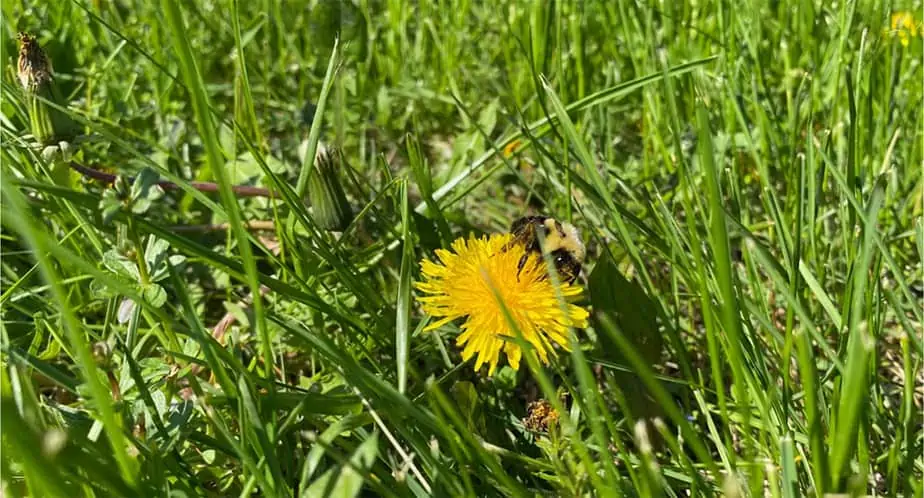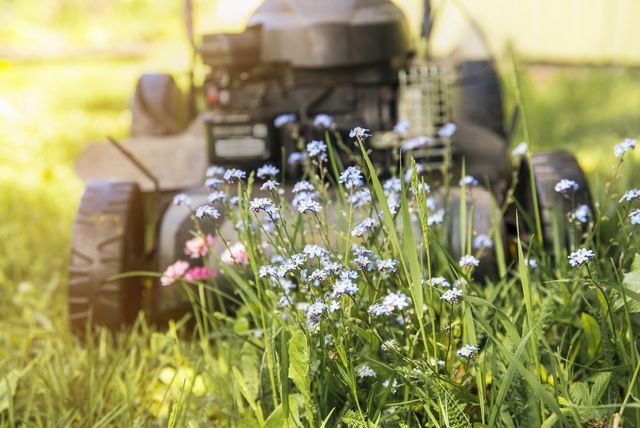No Mow May
No Mow May is an initiative to put a pause on mowing residential lawns in the month of May. The main goal of No Mow May protects and boosts the struggling populations of bees, butterflies, and other essential pollinators. By keeping your mower in storage until June, you will help local bees and butterflies thrive. Plus, these insects will pollinate your fruit and vegetable plants for you, ensuring you have a great harvest from your home garden.

Where Did No Mow May Come From?
No Mow May began in the UK in 2019. The initiative was planned in order to restore bee, butterfly, and wildflower populations that have plummeted in the UK in the last century. No Mow May was so successful at reviving local wildlife that it began to take off in the United States in 2021.
Due to the positive effects of No Mow May, more and more local governments are asking residents to put a pause on mowing for the month of May. Because bee colonies have been dying off in the United States for decades, No Mow May is crucial to saving the species that pollinate the crops we grow for food.

5 Benefits of No Mow May
The prospect of not mowing your lawn for an entire month in spring might seem like a recipe for disaster at first. After all, most of us enjoy a nice, neat lawn. However, there are some incredible benefits of not mowing in May. Read about them below:
Protect Bees and Other Essential Species
Bees and butterflies feed on the nectar and pollen found in flowers to survive. Dandelions, clover, and wild violets all support local bee and butterfly populations. By participating in No Mow May, you let the natural flowers in your lawn provide food for pollinating species.
Bees, butterflies, moths, and other pollinators have experienced unprecedented die-off events in North America and the rest of the world. As these pollinators die, essential crops go unpollinated and fail. This leads to rising food prices since there is less food produced from farming. So, you will not only help local wildlife if you participate in No Mow May, but you’ll also save money at the grocery store.
Ensure Your Fruits and Vegetables are Pollinated
If you grow fruit trees, berries, or a vegetable garden, taking part in No Mow May will ensure you get a great harvest. When you allow dandelions and other plants to flower in your yard, you’ll attract bees and butterflies. These pollinators will also visit your garden plants, where they will pollinate the flowers there. The flowers on your fruits and vegetables must be pollinated, or they won’t produce any fruit. So, not mowing in May means your garden will produce more homegrown food than ever before.
If you do mow your yard during May, you risk driving off pollinators and causing further population collapse. Without enough local pollinators, your garden will go unpollinated. This results in plants that flower, but don’t produce any food.
Reduce Your Spring Workload
If you don’t mow your yard in May, you’ll save yourself a lot of time and work. Instead of hours spent mowing and edging the lawn, you can focus on household spring cleaning tasks or that weekend renovation project you’ve been putting off. No Mow May is an excellent way to give yourself more free time while doing something great for the environment.
Instead of doing traditional lawn care in May, consider spending that time selecting and planting varieties for a vegetable garden or flower bed. This way, you can still improve the look of your yard even while you’re letting wildflowers bloom on your lawn.
Save Money on Gas
Lawn mowers devour gasoline, so you have to pay at the pump to mow your yard. Even if you use an electric mower, that energy use shows up on your monthly bill. You can avoid all of these costs by not mowing your lawn in May. So, No Mow May benefits the bees and puts a little extra cash in your wallet.
Participating in No Mow May won’t do damage to your lawn either. Reducing your frequency of mowing for a month helps combat habitat loss for bees and butterflies, but your grass will bounce back once you start mowing again in June. Just remember to mow on the tallest height the first time you mow again, then gradually work your way down to the desired length in the following weeks.
Enjoy Flowers in Your Yard
What we often consider weeds are actually fantastic wildflowers. Dandelions, clover, creeping Charlie, wild violets, buttercups, and goldenrod commonly grow in lawns throughout North America. Not only are these plants food for pollinators, but they are also beautiful flowers that can help your unmowed lawn look like a beautiful farm meadow, once you get used to the long grass.
Not only are pollinators such as bees at risk from excessive mowing, but wildflower species are also too. By allowing wild flowering plants to bloom and cast seeds, you will help prevent a decline in natural plant biodiversity. So, No Mow May is good for the plants, the bees, and you.